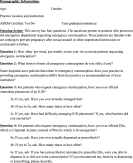Survey of emergency physicians regarding emergency contraception
Correspondence
- Corresponding author at: Department of Emergency Medicine, Ichan School of Medicine at Mount Sinai, 3 E 101st St, Room 218, New York, NY, USA 10029. Tel.: +1 212 824 8094.

Correspondence
- Corresponding author at: Department of Emergency Medicine, Ichan School of Medicine at Mount Sinai, 3 E 101st St, Room 218, New York, NY, USA 10029. Tel.: +1 212 824 8094.
 Article Info
Article Info
To view the full text, please login as a subscribed user or purchase a subscription. Click here to view the full text on ScienceDirect.

To access this article, please choose from the options below
Purchase access to this article
Claim Access
If you are a current subscriber with Society Membership or an Account Number, claim your access now.
Subscribe to this title
Purchase a subscription to gain access to this and all other articles in this journal.
Institutional Access
Visit ScienceDirect to see if you have access via your institution.
Conflict of interest: MAP is supported by the National Heart, Lung, and Blood Institute of the National Institutes of Health under award number 5K12 HL109005 . MPL is supported by a grant from the Emergency Medicine Foundation. There are no conflicts of interest to report. The funding sources had no involvement in the study execution or manuscript composition.
Related Articles
Searching for related articles..


